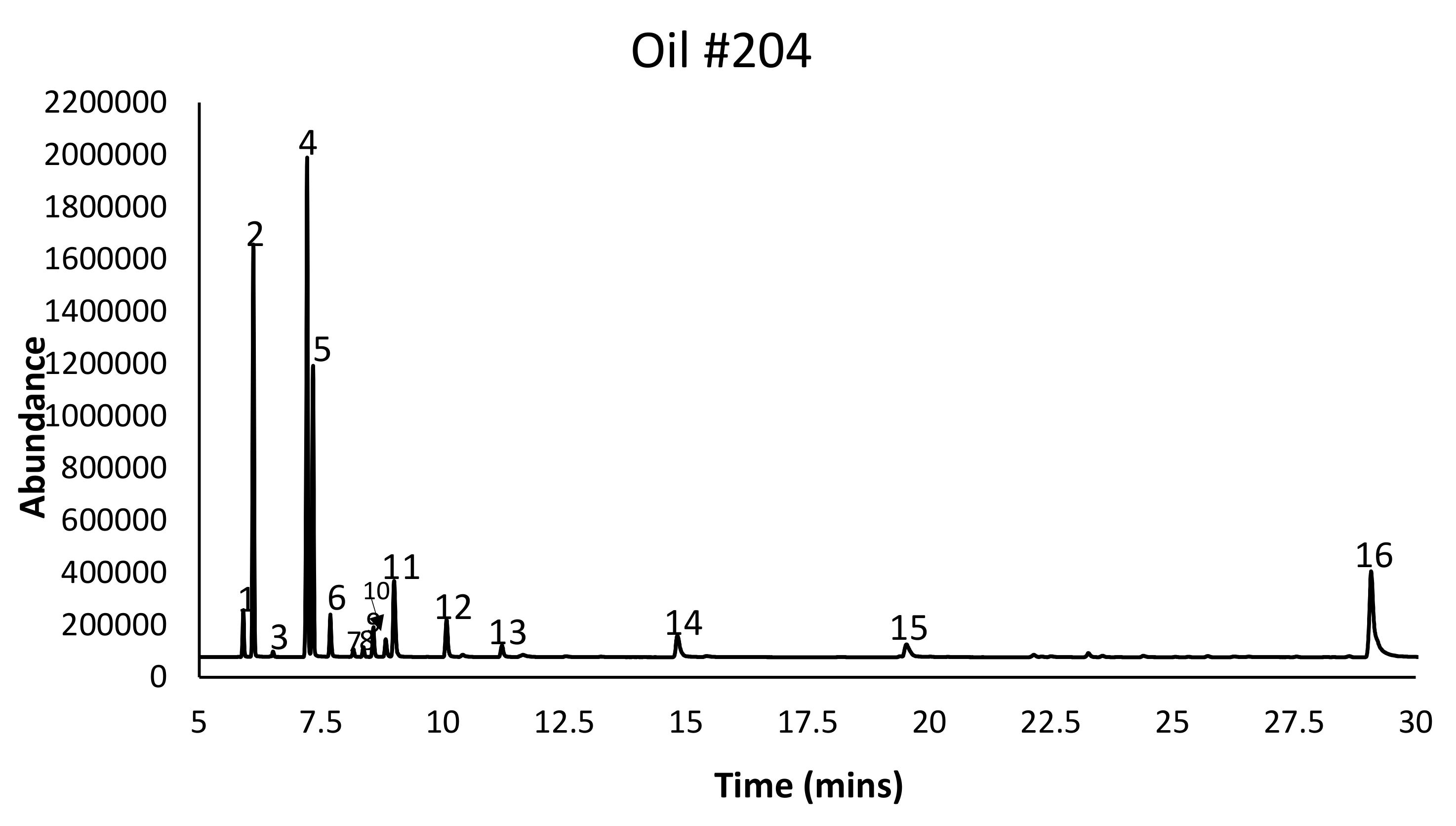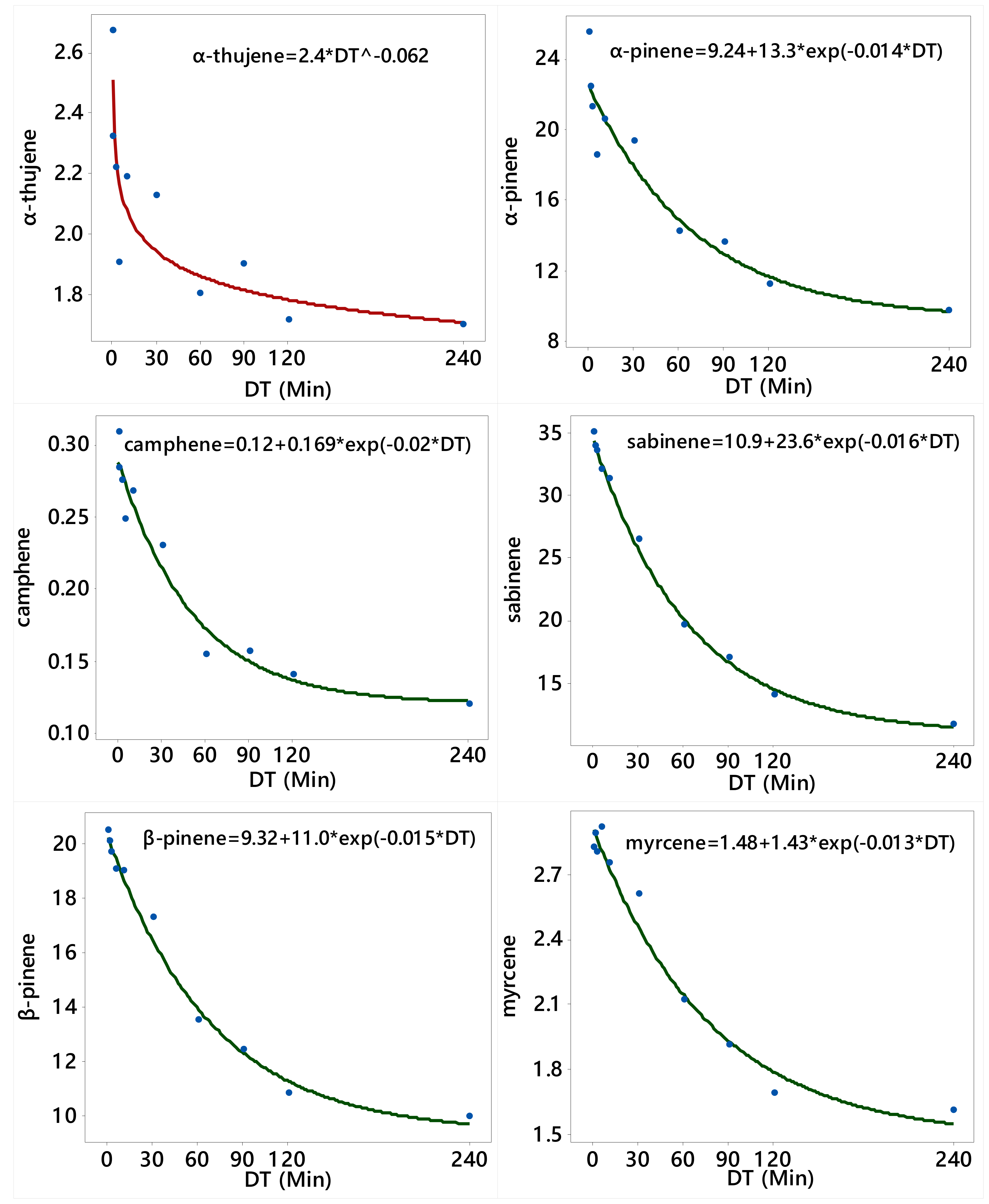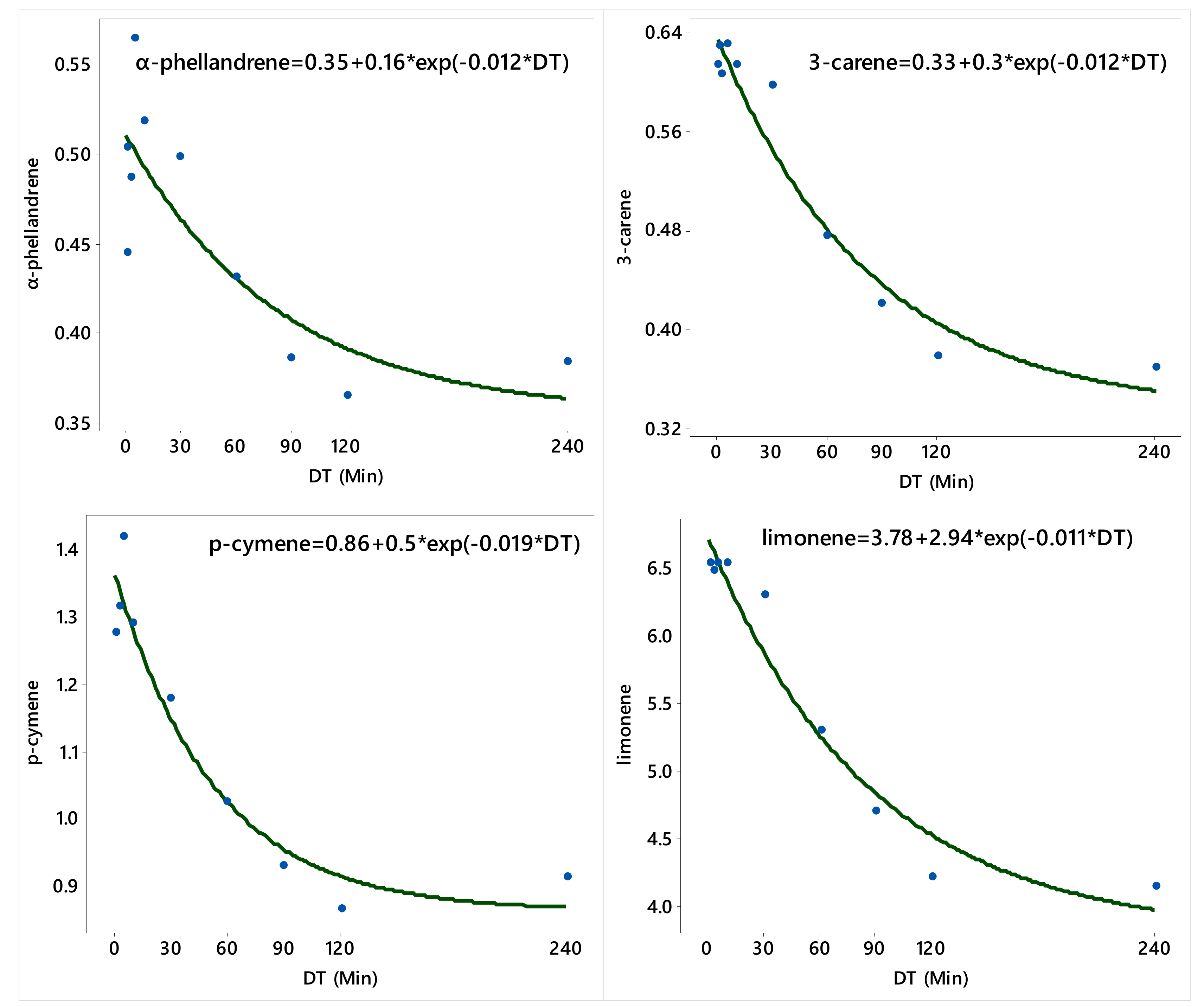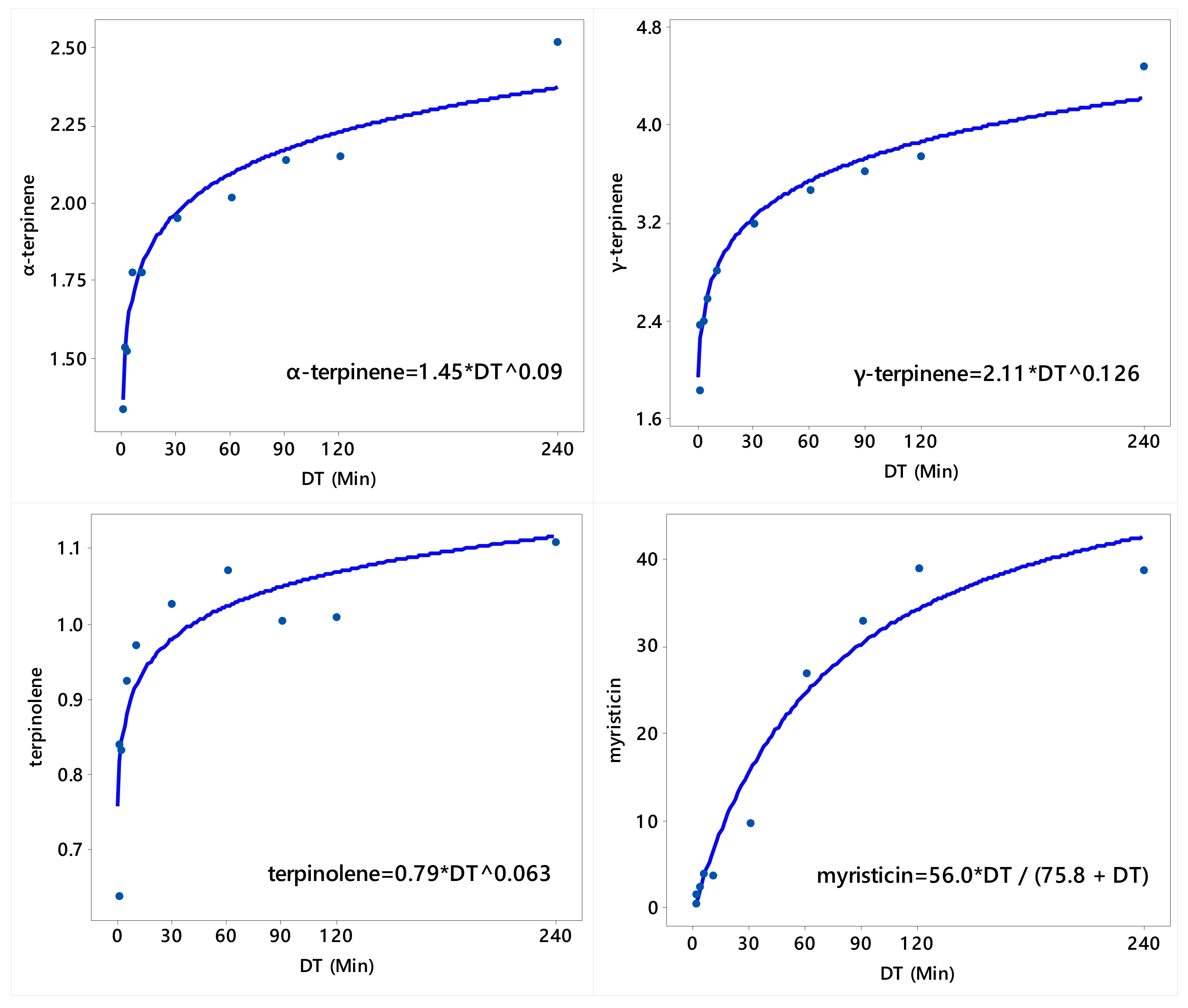Utilization of Nutmeg (Myristica fragrans Houtt.) Seed Hydrodistillation Time to Produce Essential Oil Fractions with Varied Compositions and Pharmacological Effects
Abstract
1. Introduction
2. Results
2.1. Effect of Distillation Time (DT) on Oil Profile
2.2. Effect of Distillation Time (DT) on Antimalarial and Antimicrobial Activities
3. Discussion
4. Materials and Methods
4.1. Hydrodistillation and the Collection of Nutmeg EO Fractions During Different Timeframes (DT)
4.2. Procedure for Preparing the Nutmeg for Hydrodistillation
4.3. Gas Chromatography, Mass Spectroscopy, Flame Ionization Detector (GC/MS/FID) Analysis
4.4. Statistical Analyses
4.5. Antimalarial Activity Testing of Nutmeg EO from Various DT
4.6. Antimicrobial Activity Testing
5. Conclusions
Author Contributions
Funding
Acknowledgments
Conflicts of Interest
References
- Cao, G.Y.; Xu, W.; Yang, X.W.; Gonzalez, F.J.; Li, F. New neolignans from the seeds of Myristica fragrans that inhibit nitric oxide production. Food Chem. 2015, 15, 231–237. [Google Scholar] [CrossRef] [PubMed]
- Stein, U.; Greyer, H.; Hentschel, H. Nutmeg (myristicin) poisoning—Report on a fatal case and a series of cases recorded by a poison information centre. Forensic Sci. Int. 2001, 118, 87–90. [Google Scholar] [CrossRef]
- Marcelle, G.B. Production, Handling and Processing of Nutmeg and Mace and Their Culinary Uses; FAO Regional Office for Latin America and the Caribbean: Santiago, Chile, 1995. [Google Scholar]
- Weil, A.T. Nutmeg as a narcotic. Econ. Bot. 1965, 19, 194–217. [Google Scholar] [CrossRef]
- TOXICOLOGY MD. Nutmeg Factfile (FAQ). Br. Med. J. 1970, 1, 754. [Google Scholar]
- Norman, J. The complete book of spices; RD Press: London, UK, 1990. [Google Scholar]
- Britannica, E. Encyclopædia Britannica; University of Chicago: Chicago, IL, USA, 1993. [Google Scholar]
- Periasamy, G.; Karim, A.; Gibrelibanos, M.; Gebremedhin, G.; Gilani, A. Nutmeg (Myristica fragrans Houtt.) Oils. In Essential Oils in Food Preservation, Flavor and Safety; Academic Press: Amsterdam, The Netherlands, 2016; pp. 607–616. [Google Scholar]
- Van Alfen, N.K. Encyclopedia of agriculture and food systems; Elsevier: Amsterdam, The Netherlands, 2014. [Google Scholar]
- Singh, G.; Marimuthu, P.; Heluani, C.S.; Catalan, C. Antimicrobial and antioxidant potentials of essential oil and acetone extract of Myristica fragrans Houtt.(aril part). J. Food Sci. 2005, 70, 141–148. [Google Scholar] [CrossRef]
- Gopalakrishnan, M. Chemical composition of Nutmeg and mace. J. Spices Aromat. Crops. 1992, 1, 49–54. [Google Scholar]
- Saxena, R.; Patil, P. Phytochemical studies on Myristica fragrance essential oil. Biol. Forum-An Int. J. 2012, 4, 62–64. [Google Scholar]
- Zheljazkov, V.D.; Gawde, A.; Cantrell, C.L.; Astatkie, T.; Schlegel, V. Distillation time as tool for improved antimalarial activity and differential oil composition of cumin seed oil. PLoS ONE 2015, 10, e0144120. [Google Scholar] [CrossRef] [PubMed]
- Van Gils, C.; Cox, P.A. Ethnobotany of nutmeg in the Spice Islands. J. Ethnopharmacol. 1994, 42, 117–124. [Google Scholar] [CrossRef]
- Burt, S. Essential oils: Their antibacterial properties and potential applications in foods—A review. Int. J. Food Microbiol. 2004, 94, 223–253. [Google Scholar] [CrossRef] [PubMed]
- Mahfuz, I.; Khalequzzaman, M. Contact and fumigant toxicity of essential oils against Callosobruchus maculatus. Univ. J. Zool. Rajshahi Univ. 2007, 26, 63–66. [Google Scholar] [CrossRef][Green Version]
- Wardono, P.; Mujahidin, D.; Lailiyya, N. Analysis of Myristica Fragrans Oil as Sleep Inducing Agents for Developing Aromatic Bio-Composite Material. Adv. Sci. Let. 2018, 24, 2395–2399. [Google Scholar] [CrossRef]
- Alibabaie, M.; Safaralizadeh, M.H. Fumigant toxicity of Nutmeg seed essential oil (Myristica fragrans Houtt.)(MF, Myristicaceae) on cowpea weevil, Callosobruchus maculatus F. (Coleoptera: Bruchidae). In New Horizons in Insect Science: Towards Sustainable Pest Management; Springer: New Delhi, India, 2015; pp. 127–133. [Google Scholar]
- Zhang, W.K.; Tao, S.S.; Li, T.T.; Li, Y.S.; Li, X.J.; Tang, H.B.; Cong, R.H.; Ma, F.L.; Wan, C.J. Nutmeg oil alleviates chronic inflammatory pain through inhibition of COX-2 expression and substance P release in vivo. J. Food Nut. Res. 2016, 60, 30849. [Google Scholar] [CrossRef] [PubMed]
- Nurjanah, S.; Putri, I.L.; Sugiarti, D.P. Antibacterial Activity of Nutmeg Oil. KnE Life Sci. 2017, 26, 563–569. [Google Scholar] [CrossRef]
- Maxia, A.; Falconieri, D.; Piras, A.; Porcedda, S.; Marongiu, B.; Frau, M.A.; Gonçalves, M.J.; Cabral, C.; Cavaleiro, C.; Salgueiro, L. Chemical Composition and Antifungal Activity of Essential Oils and Supercritical CO2 Extracts of Apium nodiflorum (L.) Lag. Mycopathologia 2012, 174, 61–67. [Google Scholar] [CrossRef] [PubMed]
- Goel, D.; Singh, V.; Ali, M.; Mallavarupu, G.R.; Kumar, S. Essential oils of petal, leaf and stem of the antimalarial plant Artemisia annua. J. Nat. Med. 2007, 61, 187. [Google Scholar] [CrossRef]
- Zheljazkov, V.D.; Astatkie, T.; O’Brocki, B.; Jeliazkova, E. Essential oil composition and yield of anise from different distillation times. HortScience 2013, 48, 1393–1396. [Google Scholar] [CrossRef]
- Adams, R.P. Identification of Essential Oil Components by Gas Chromatography/Mass Spectrometry, 4th ed; Allured Publishing Corporation: Carol Stream, IL, USA, 2007. [Google Scholar]
- Montgomery, D.C. Design and Analysis of Experiments, 9th ed.; Wiley: Hoboken, NJ, USA, 2017. [Google Scholar]
- SAS Institute Inc. SAS/STAT® 9.4 User’s Guide; SAS Institute Inc.: Cary, NC, USA, 2014. [Google Scholar]
- Bates, D.M.; Watts, D.G. Nonlinear Regression and its Applications; Wiley: Hoboken, NJ, USA, 2007. [Google Scholar]
- Bharate, S.B.; Khan, S.I.; Yunus, N.A.; Chauthe, S.K.; Jacob, M.R.; Tekwani, B.L.; Khan, I.A.; Singh, I.P. Antiprotozoal and antimicrobial activities of O-alkylated and formylated acylphloroglucinols. Biol. Med. Chem. 2007, 15, 87–96. [Google Scholar] [CrossRef] [PubMed]
Sample Availability: Samples of some of the compounds are available from the authors. |




| DT (min) | EO Content | α-Thujene | α-Pinene | Camphene | Sabinene | β-Pinene |
|---|---|---|---|---|---|---|
| 0.0–0.5 | 0.684 c | 2.67 a | 25.5 a | 0.309 a | 35.0 a | 20.5 a |
| 0.5–1.0 | 0.258 de | 2.32 ab | 22.4 ab | 0.284 ab | 33.9 ab | 20.1 a |
| 1.0–2.5 | 0.382 cde | 2.22 abc | 21.2 ab | 0.275 ab | 33.5 ab | 19.7 ab |
| 2.5–5.0 | 0.421 cde | 1.91 bc | 18.5 bc | 0.248 b | 32.0 abc | 19.1 abc |
| 5.0–10 | 0.742 c | 2.19 abc | 20.5 b | 0.268 ab | 31.3 abc | 19.0 abc |
| 10–30 | 1.405 b | 2.13 abc | 19.3 b | 0.230 b | 26.5 bc | 17.3 bc |
| 30–60 | 0.593 cd | 1.80 bc | 14.2 cd | 0.154 c | 19.6 de | 13.5 d |
| 60–90 | 0.430 cde | 1.90 bc | 13.6 d | 0.157 c | 17.0 ef | 12.4 de |
| 90–120 | 0.209 e | 1.71 c | 11.2 d | 0.141 c | 14.1 fg | 10.8 e |
| 120–240 | 0.518 cde | 1.70 c | 9.8 d | 0.120 c | 11.7 g | 9.9 e |
| 0–240 Control | 5.811 a | 2.30 ab | 19.7 b | 0.241 b | 25.6 cd | 16.7 c |
| DT (min) | Myrcene | α-Phellandrene | 3-Carene | α-Terpinene | p-Cymene | Limonene |
|---|---|---|---|---|---|---|
| 0.0–0.5 | 2.82 ab | 0.444 bcd | 0.613 a | 1.33 e | 1.060 bcd | 5.72 cd |
| 0.5–1.0 | 2.89 a | 0.504 abc | 0.629 a | 1.53 de | 1.276 ab | 6.53 a |
| 1.0–2.5 | 2.80 ab | 0.486 abc | 0.606 a | 1.52 de | 1.315 ab | 6.48 a |
| 2.5–5.0 | 2.91 a | 0.564 a | 0.630 a | 1.77 cd | 1.419 a | 6.53 a |
| 5.0–10 | 2.75 ab | 0.518 ab | 0.613 a | 1.78 cd | 1.291 ab | 6.53 a |
| 10–30 | 2.61 ab | 0.498 abc | 0.596 a | 1.95 bc | 1.179 abcd | 6.29 ab |
| 30–60 | 2.12 c | 0.431 bcd | 0.475 ab | 2.01 bc | 1.024 bcd | 5.29 d |
| 60–90 | 1.91 cd | 0.386 cd | 0.421 ab | 2.13 b | 0.929 cd | 4.70 e |
| 90–120 | 1.68 d | 0.365 d | 0.377 b | 2.15 b | 0.864 d | 4.21 ef |
| 120–240 | 1.61 d | 0.384 cd | 0.369 b | 2.52 a | 0.912 d | 4.14 f |
| 0–240 Control | 2.50 b | 0.451 abcd | 0.540 ab | 1.92 bc | 1.227 abc | 5.84 bc |
| DT (min) | γ-Terpinene | Terpinolene | Terpinen-4-ol | Safrole | Myristicin |
|---|---|---|---|---|---|
| 0.0–0.5 | 1.83 h | 0.636 e | 1.03 e | 0.000 g | 0.47 f |
| 0.5–1.0 | 2.36 g | 0.838 cd | 2.09 de | 0.785 f | 1.44 e |
| 1.0–2.5 | 2.40 g | 0.832 d | 2.97 cd | 1.228 ef | 2.39 de |
| 2.5–5.0 | 2.57 fg | 0.924 bcd | 4.13 abc | 1.714 cde | 3.79 d |
| 5.0–10 | 2.80 efg | 0.971 abcd | 4.11 abc | 1.564 cde | 3.71 d |
| 10–30 | 3.19 cde | 1.024 ab | 5.13 a | 2.283 bc | 9.75 c |
| 30–60 | 3.46 bcd | 1.069 ab | 4.50 ab | 3.273 a | 26.94 b |
| 60–90 | 3.62 bc | 1.003 abc | 2.90 cd | 2.590 ab | 32.87 ab |
| 90–120 | 3.73 b | 1.008 ab | 1.91 de | 2.158 bcd | 38.77 a |
| 120–240 | 4.47 a | 1.107 a | 1.35 e | 1.483 def | 38.57 a |
| 0–240 Control | 3.07 def | 0.938 bcd | 3.25 bcd | 1.996 bcd | 13.16 c |
| DT (min) | aP. falciparum D6 | bC. neoformans | bC. albicans | bE. coli |
|---|---|---|---|---|
| 1.0–2.5 | 39 | 0 | 10 | 4 |
| 10–30 | 16 | 9 | 9 | 8 |
| 120–240 | 14 | 55 | 11 | 6 |
| 0–240 | 18 | 0 | 6 | 0 |
© 2020 by the authors. Licensee MDPI, Basel, Switzerland. This article is an open access article distributed under the terms and conditions of the Creative Commons Attribution (CC BY) license (http://creativecommons.org/licenses/by/4.0/).
Share and Cite
Ibrahim, M.A.; Cantrell, C.L.; Jeliazkova, E.A.; Astatkie, T.; Zheljazkov, V.D. Utilization of Nutmeg (Myristica fragrans Houtt.) Seed Hydrodistillation Time to Produce Essential Oil Fractions with Varied Compositions and Pharmacological Effects. Molecules 2020, 25, 565. https://doi.org/10.3390/molecules25030565
Ibrahim MA, Cantrell CL, Jeliazkova EA, Astatkie T, Zheljazkov VD. Utilization of Nutmeg (Myristica fragrans Houtt.) Seed Hydrodistillation Time to Produce Essential Oil Fractions with Varied Compositions and Pharmacological Effects. Molecules. 2020; 25(3):565. https://doi.org/10.3390/molecules25030565
Chicago/Turabian StyleIbrahim, Mohamed A., Charles L. Cantrell, Ekaterina A. Jeliazkova, Tess Astatkie, and Valtcho D. Zheljazkov. 2020. "Utilization of Nutmeg (Myristica fragrans Houtt.) Seed Hydrodistillation Time to Produce Essential Oil Fractions with Varied Compositions and Pharmacological Effects" Molecules 25, no. 3: 565. https://doi.org/10.3390/molecules25030565
APA StyleIbrahim, M. A., Cantrell, C. L., Jeliazkova, E. A., Astatkie, T., & Zheljazkov, V. D. (2020). Utilization of Nutmeg (Myristica fragrans Houtt.) Seed Hydrodistillation Time to Produce Essential Oil Fractions with Varied Compositions and Pharmacological Effects. Molecules, 25(3), 565. https://doi.org/10.3390/molecules25030565






